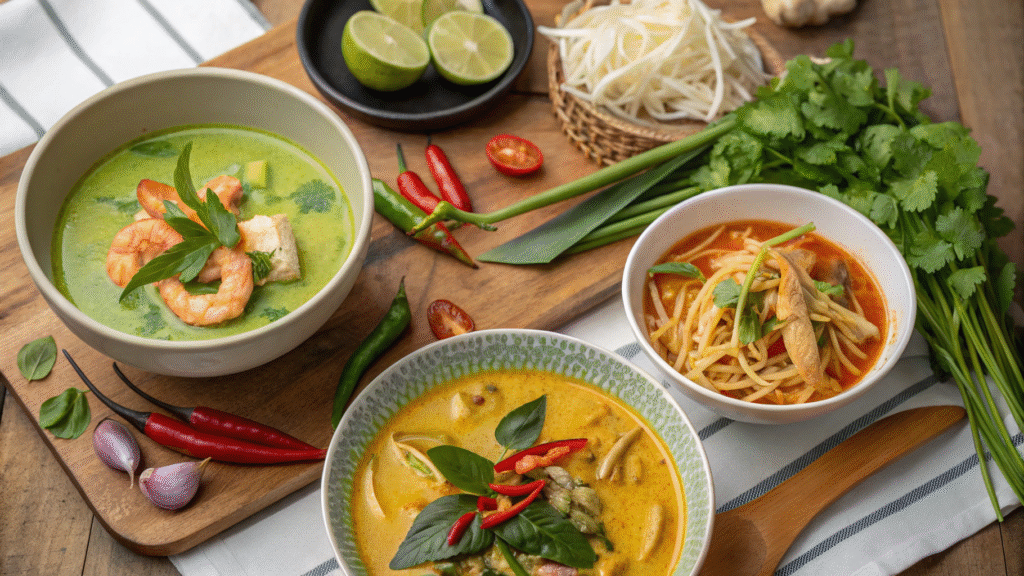🌶️ Introduction: A Symphony on a Plate
Have you ever taken a bite of Thai food and felt like your taste buds were going through a roller coaster of joy? That’s not an accident. Thai cuisine is often considered one of the most flavorful in the world — not just because it’s spicy or exotic, but because it balances taste like few others can.
Sweet, salty, sour, spicy, and sometimes bitter — all in one bite.
Thai food is less about following rigid rules and more about harmony. It’s about achieving the perfect equilibrium between five essential flavor elements. Whether you’re digging into a bowl of Tom Yum soup or savoring Pad Thai, each bite is carefully calibrated to stimulate, satisfy, and surprise.
So, is Thai food the perfect balance of flavor? Let’s break it down and find out.
🧂 Chapter 1: The Five Core Flavors of Thai Cuisine
At the heart of Thai cooking lies one mission: balance. Unlike some cuisines that emphasize one taste (like salty or sweet), Thai food strives to bring multiple flavors together without overpowering each other.
Let’s look at the five:
1. Sweet
- Comes from palm sugar, coconut milk, sweet chili sauces, and even fruits like pineapple.
- Softens the blow of spicy and sour notes.
- Common in dishes like:
- Pad Thai
- Massaman curry
- Thai iced tea
2. Salty
- Usually comes from fish sauce, soy sauce, or shrimp paste.
- Adds depth and umami to nearly every dish.
- Used in:
- Stir-fried morning glory (Pak Boong Fai Daeng)
- Som Tum (green papaya salad)
- Most curries
3. Sour
- One of Thai food’s most distinctive notes.
- Comes from lime juice, tamarind, vinegar, green mango.
- Highlights:
- Tom Yum Goong (hot and sour shrimp soup)
- Pad Thai’s tamarind base
- Yum Nua (Thai beef salad)
4. Spicy
- Chilies are king in Thai cuisine.
- Ranges from mild warmth to full-on fire — but always layered, not flat.
- Found in:
- Green curry
- Laab (minced meat salad)
- Spicy basil chicken (Pad Krapow)
5. Bitter
- Less common but still important for depth.
- Comes from bitter melon, herbs like neem, or roasted spices.
- Often plays a supporting role in balancing sweetness and acidity.
🍛 Chapter 2: The Dishes That Show It Best
Let’s explore some signature Thai dishes that perfectly show this balance in action.
🥘 Tom Yum Goong (Hot & Sour Shrimp Soup)
- Sour from lime juice and lemongrass
- Spicy from chilies
- Salty from fish sauce
- Aromatic with galangal, kaffir lime leaves
- Umami-rich from mushrooms and shrimp
Why it works: It’s light, brothy, and zesty — every sip keeps you guessing and coming back.
🍜 Pad Thai
- Sweet from palm sugar
- Sour from tamarind
- Salty from fish sauce
- Crunchy & creamy with peanuts and egg
- Spicy (optional, with chili flakes)
Why it’s beloved: It’s familiar and comforting, yet endlessly customizable. You can adjust any element to suit your mood.
🍲 Green Curry (Gaeng Keow Wan)
- Creamy & sweet from coconut milk
- Spicy & herbal from green chilies and basil
- Salty from shrimp paste or fish sauce
- Savory from meats like chicken or beef
Why it’s a masterpiece: It layers flavors slowly. The spice doesn’t hit all at once — it builds and balances.
🥗 Som Tum (Green Papaya Salad)
- Crunchy texture from shredded papaya
- Sour from lime
- Sweet from palm sugar
- Salty from fish sauce
- Spicy from chili
- Slightly bitter from raw papaya and garlic
Why it’s genius: It’s a salad that eats like a main course. Light, but powerful.
🐟 Chapter 3: Ingredients That Make Thai Food Magical
You can’t talk about flavor balance without mentioning the hero ingredients that make Thai food so unique.
🧄 1. Fish Sauce (Nam Pla)
- Fermented, salty, and funky — but used wisely, it’s liquid gold.
🌿 2. Thai Basil & Kaffir Lime Leaves
- Fragrant and citrusy. Not just garnishes — they are the flavor.
🥥 3. Coconut Milk
- Adds creaminess and cools heat. Found in many curries.
🌶️ 4. Bird’s Eye Chilies
- Small but mighty. A staple in nearly every spicy Thai dish.
🍋 5. Tamarind
- Adds that addictive sweet-and-sour kick. Essential in Pad Thai and dipping sauces.
🥢 Chapter 4: Thai Food Is Meant to Be Shared
In Thailand, meals aren’t served as individual plates. Instead, it’s all about sharing and sampling:
- A typical Thai meal includes a mix of dishes: curry, salad, soup, stir-fry, and rice.
- Each dish may lean more toward one flavor — but together, they balance the entire experience.
- Think of it like a band: curry is the lead singer, but salad, soup, and sauces are the backup harmonies.
Balance isn’t just in the dish — it’s in the meal.
🌱 Chapter 5: Is Thai Food Healthy?
Absolutely — if you keep it traditional.
✅ The Good:
- Lots of fresh vegetables, herbs, and lean proteins
- Fermented foods for gut health
- Minimal dairy, and low use of processed sugar
- Gluten-free friendly (many dishes use rice noodles or jasmine rice)
❗ Watch out for:
- Dishes made overly sweet for Western tastes
- Deep-fried street food (delicious but not light!)
- Portion sizes in restaurants that stray from traditional servings
🍽️ Chapter 6: How to Eat Thai Food Like a Local
- Use a fork and spoon, not chopsticks. Fork pushes food onto the spoon — the spoon does the eating.
- Rice is the foundation. Every bite is paired with it to absorb flavor.
- Respect the chili. If you ask for “Thai spicy,” know what you’re getting into.
- Don’t expect dairy-heavy desserts — instead, look for:
- Sticky rice with mango
- Sweet coconut dumplings
- Palm sugar jellies or banana in coconut milk
🧠 Chapter 7: Thai Food’s Global Influence
From street food stalls to Michelin-starred restaurants, Thai food has gone global — but the essence remains:
- Thai chefs worldwide stick to the principle of flavor harmony.
- Fusion dishes like Thai pizza, Thai tacos, or Thai pasta still carry the DNA of balance.
- Western dishes like sweet chili wings or peanut satay sauce are rooted in Thai techniques and ingredients.
The core idea? No one flavor dominates. It’s all about the blend.
❓ Frequently Asked Questions (FAQ)
Q1: Is Thai food always spicy?
No — while many dishes are spicy, others are mild and focus more on sweet, sour, or salty elements. You can always ask for “mai phet” (not spicy) when ordering.
Q2: Can I cook Thai food at home?
Absolutely! With a few key ingredients like fish sauce, curry paste, coconut milk, and Thai basil, you can make dishes like:
- Pad Thai
- Red or green curry
- Tom Kha Gai (coconut chicken soup)
- Mango sticky rice
Q3: Is Thai food good for vegetarians or vegans?
Yes — many Thai dishes can be made with tofu and veggies. Just watch out for fish sauce, shrimp paste, and meat-based broths. Use soy sauce or mushroom sauce as substitutes.
Q4: What’s the difference between Thai and other Southeast Asian cuisines?
While Thai food shares ingredients with Vietnamese or Cambodian cuisine, it’s typically bolder in spice, sweeter in tone, and more complex in seasoning layers.
Q5: Why does Thai food always feel so satisfying?
Because it doesn’t just fill you — it activates your entire palate. You’re not just tasting salt or heat. You’re experiencing contrast and complexity in every bite.
✅ Conclusion: The Art of Thai Balance
So, is Thai food the perfect balance of flavor?
Yes — and not by accident.
Thai cuisine is a masterclass in the alchemy of taste. It’s spicy, but not overpowering. Sweet, but not cloying. Salty and sour, but never overwhelming. It’s a conversation between flavors — not a shouting match.
It’s no wonder Thai food has taken the world by storm. It invites you to sit down, share a meal, and experience a little bit of harmony — on your tongue and in your soul.
So next time you take a bite of Thai curry or spoon a mouthful of tom yum, pause for a second. Notice the balance. Feel the joy.
Because this is food that feeds more than hunger — it feeds happiness.
Want a downloadable Thai flavor guide, essential ingredient list, or a beginner recipe eBook? Let me know — I’ll create it just for your readers at salaore.fun! 🇹🇭🍜Tools

